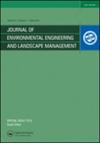AUGMENTATION OF THE URBAN GREEN INFRASTRUCTURE USING STORMWATER SURFACE RUNOFF AS A RESOURCE IN THE NICE EXPRESSWAY, KARNATAKA, INDIA
IF 1.1
4区 环境科学与生态学
Q4 ENVIRONMENTAL SCIENCES
Journal of Environmental Engineering and Landscape Management
Pub Date : 2022-03-03
DOI:10.3846/jeelm.2022.16394
引用次数: 2
Abstract
Urban areas, characterized by impervious surfaces, produce storm water runoff which during unexpected heavy rainfall exceeds the carrying capacity of the storm water drainage system causing urban flooding. Transport expressways are massive hard-scaped surfaces generating large amounts of polluted surface run-off during the rains. In the case of the Nandi Infrastructure Corridor Enterprises (NICE) Expressway at Bengaluru, India, which is also a tolled road, the demonstration is about using the surface run-off or stormwater as a resource for developing urban green infrastructure complementing the transport grey infrastructure. The functions of urban green infrastructure include air quality improvement, microclimate modification, storm water management, biodiversity, recreational opportunities and visual aesthetics. Here we show, that the surface runoff or stormwater is effectively channelled to the areas around, to mark the beginning of a well-planned and executed drainage system, maintenance-free landscape and technically a sound, urban green infrastructure in the form of site-specific models of Rain Gardens. The same models can be used in other transport expressways as they are the indicators of economic growth and connectivity although would require to be customized as per the city and its climatic conditions. This paper explores three different scenarios with a typical model of development of green infrastructure along the transport expressway tailormade for each of the situations. While in the first and the second models, the Central Rain Garden and the Edge Rain Garden have been respectively proposed, the third model explores a comparatively complex scenario in the form of an Intersection Rain Garden.印度卡纳塔克邦尼斯高速公路利用雨水地表径流资源加强城市绿色基础设施
以不透水表面为特征的城市地区会产生暴雨径流,在意外的强降雨期间,暴雨径流超过了暴雨排水系统的承载能力,导致城市洪水泛滥。运输高速公路是巨大的硬景观表面,在下雨时会产生大量受污染的地表径流。以印度班加罗尔的南迪基础设施走廊企业(NICE)高速公路为例,该高速公路也是一条收费公路,该示范旨在利用地表径流或雨水作为资源,发展城市绿色基础设施,补充交通灰色基础设施。城市绿色基础设施的功能包括改善空气质量、改善小气候、雨水管理、生物多样性、娱乐机会和视觉美学。在这里,我们展示了地表径流或雨水被有效地引导到周围地区,标志着一个精心规划和执行的排水系统、免维护景观和技术上健全的城市绿色基础设施的开始,其形式是雨水花园的特定场地模型。同样的模型也可以用于其他交通高速公路,因为它们是经济增长和连通性的指标,尽管需要根据城市及其气候条件进行定制。本文探讨了三种不同的场景,并针对每种情况定制了一个典型的交通高速公路绿色基础设施发展模型。在第一个和第二个模型中,分别提出了中央雨水花园和边缘雨水花园,而第三个模型以交叉雨水花园的形式探索了一个相对复杂的场景。
本文章由计算机程序翻译,如有差异,请以英文原文为准。
求助全文
约1分钟内获得全文
求助全文
来源期刊
CiteScore
1.90
自引率
7.70%
发文量
41
审稿时长
>12 weeks
期刊介绍:
The Journal of Environmental Engineering and Landscape Management publishes original research about the environment with emphasis on sustainability.

 求助内容:
求助内容: 应助结果提醒方式:
应助结果提醒方式:


